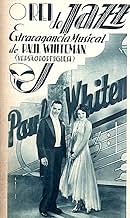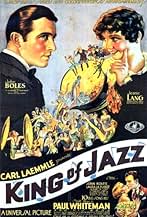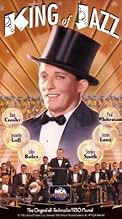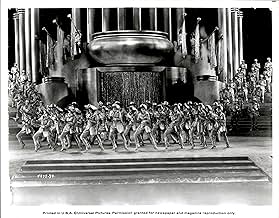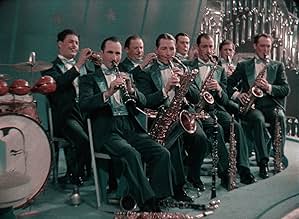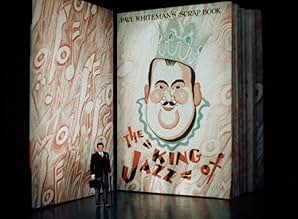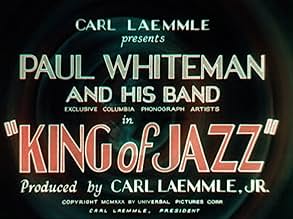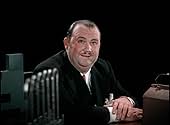IMDb RATING
6.7/10
1.8K
YOUR RATING
A rotund bandleader leads a series of theatrical sketches, dance numbers, special effects, and animated segments.A rotund bandleader leads a series of theatrical sketches, dance numbers, special effects, and animated segments.A rotund bandleader leads a series of theatrical sketches, dance numbers, special effects, and animated segments.
- Directors
- Writers
- Stars
- Won 1 Oscar
- 4 wins total
Harry Barris
- One of the Rhythm Boys
- (as The Rhythm Boys)
Bing Crosby
- One of the Rhythm Boys
- (as The Rhythm Boys)
Al Rinker
- One of the Rhythm Boys
- (as The Rhythm Boys)
Carla Laemmle
- Chorine
- (as Beth Laemmle)
- Directors
- Writers
- All cast & crew
- Production, box office & more at IMDbPro
Featured reviews
1930's King of Jazz is the strangest and most surreal of the early sound cycle of movie studio revues. Very few films shot completely in two-strip Technicolor survive - this is one of them. Warner Bros. probably made the most all-Technicolor films in the early sound era, but since most of them were Vitaphone the films have long since been lost in most cases.
The 1929 and 1930 early sound revues were made by the studios primarily to showcase their talent in an all-talking setting. MGM's "Hollywood Revue of 1929" started the cycle, and did a pretty good job. However, other studios lost sight of the goal and the revues that followed were often clumsily put together and didn't even showcase talent that belonged to the studio.
"The King of Jazz" is a surprise not only because it holds up so well with time, but because it is such a non-typical product for Universal Studios of that era. Universal of the 20's and 30's mainly made westerns for rural moviegoers with an occasional prestige picture and they were beginning to dabble in the horror genre for which the studio is most remembered. However, at this time they were also known for their thrift, which went out the window when they made this film. The film starts out with a cartoon showing how Paul Whiteman - who called himself The King of Jazz - discovered Jazz. What follows are a sequence of musical and comedy routines. This film doesn't make the mistake of trying to sew the numbers together with some maudlin backstage melodrama. It simply presents the numbers in sequence. Most of the talent here is not under long-term contract to Universal. Laura LaPlante is one of the rare exceptions to that rule. The musical numbers are a delight and it is great to see Bing Crosby at the very beginning of his career. The Brox Sisters light up this film just as they did MGM's revue with "Singin in the Rain". The whole thing is so lively and done with with such innovation and energy considering the static camera of the early talkie era that I can't believe Universal has never thought to put this on DVD. They made this one great musical and didn't really make another one until 1936's "Showboat".
My favorite number is "Song of the Dawn" featuring handsome John Boles with his piercing eyes in close up during most of the number belting out a song with that wonderful tenor voice of his. The most memorable number though has got to be "Happy Feet" with dancing shoes and the Sisters G as singing heads in a shoebox. This number also has the aptly named Al "Rubber Legs" Norman showing us the moon dance 28 years before Michael Jackson was even born.
Highly recommended for the fun of it all.
The 1929 and 1930 early sound revues were made by the studios primarily to showcase their talent in an all-talking setting. MGM's "Hollywood Revue of 1929" started the cycle, and did a pretty good job. However, other studios lost sight of the goal and the revues that followed were often clumsily put together and didn't even showcase talent that belonged to the studio.
"The King of Jazz" is a surprise not only because it holds up so well with time, but because it is such a non-typical product for Universal Studios of that era. Universal of the 20's and 30's mainly made westerns for rural moviegoers with an occasional prestige picture and they were beginning to dabble in the horror genre for which the studio is most remembered. However, at this time they were also known for their thrift, which went out the window when they made this film. The film starts out with a cartoon showing how Paul Whiteman - who called himself The King of Jazz - discovered Jazz. What follows are a sequence of musical and comedy routines. This film doesn't make the mistake of trying to sew the numbers together with some maudlin backstage melodrama. It simply presents the numbers in sequence. Most of the talent here is not under long-term contract to Universal. Laura LaPlante is one of the rare exceptions to that rule. The musical numbers are a delight and it is great to see Bing Crosby at the very beginning of his career. The Brox Sisters light up this film just as they did MGM's revue with "Singin in the Rain". The whole thing is so lively and done with with such innovation and energy considering the static camera of the early talkie era that I can't believe Universal has never thought to put this on DVD. They made this one great musical and didn't really make another one until 1936's "Showboat".
My favorite number is "Song of the Dawn" featuring handsome John Boles with his piercing eyes in close up during most of the number belting out a song with that wonderful tenor voice of his. The most memorable number though has got to be "Happy Feet" with dancing shoes and the Sisters G as singing heads in a shoebox. This number also has the aptly named Al "Rubber Legs" Norman showing us the moon dance 28 years before Michael Jackson was even born.
Highly recommended for the fun of it all.
"King Of Jazz" is a museum piece. Let's face it, anyone under 50 probably never heard of Paul Whiteman, and anyone under 40 only knows Bing Crosby from his Christmas album. That leaves the rest of us.
For The Rest Of Us, it doesn't get any better than "King Of Jazz". That, of course, was Paul Whiteman, rotund band leader of a bygone era who is the nominal star of this film. He was not an actor, and so the film is given over to actors and other entertainers. The accent here is on 'entertainer', as this movie is festooned with lots and lots of them.
Ever see Bing Crosby with his real hair? Ever see the Radio City Rockettes, thunder-thighed in the late 20's? Ever see George Gershwin in a movie? How about vaudevillian Al Norman with his rubber-legged dancing? It's all here, in a non-stop revue of old and almost-forgotten songs and dance numbers (there are 18 in all), interspersed with blackouts and comedy skits. Plus, it's in color (sort of) - actually, it's primitive 2 strip color.
I could go on and on but if you are a hard-core movie fan or a film historian, "King Of Jazz" is for you. The jokes are stale, the singers still trilled their 'R's, and the gowns in the bridal number are so out of style they are probably coming back. The overall effect was both sheer delight and visually overwhelming and I wished it would never end. It is available only on VHS and hasn't been seen on TV in years. It is a must for The Rest Of Us.
P.S. Ever see Paul Whiteman tap dance?
For The Rest Of Us, it doesn't get any better than "King Of Jazz". That, of course, was Paul Whiteman, rotund band leader of a bygone era who is the nominal star of this film. He was not an actor, and so the film is given over to actors and other entertainers. The accent here is on 'entertainer', as this movie is festooned with lots and lots of them.
Ever see Bing Crosby with his real hair? Ever see the Radio City Rockettes, thunder-thighed in the late 20's? Ever see George Gershwin in a movie? How about vaudevillian Al Norman with his rubber-legged dancing? It's all here, in a non-stop revue of old and almost-forgotten songs and dance numbers (there are 18 in all), interspersed with blackouts and comedy skits. Plus, it's in color (sort of) - actually, it's primitive 2 strip color.
I could go on and on but if you are a hard-core movie fan or a film historian, "King Of Jazz" is for you. The jokes are stale, the singers still trilled their 'R's, and the gowns in the bridal number are so out of style they are probably coming back. The overall effect was both sheer delight and visually overwhelming and I wished it would never end. It is available only on VHS and hasn't been seen on TV in years. It is a must for The Rest Of Us.
P.S. Ever see Paul Whiteman tap dance?
"The King Of Jazz" 1930, is a wonderful example of just what the movies could do in the late 20's early 30's if they put their mind to it. The technical achievement is extremely high, for a film of this period, and one wonders at how cinema audiences of 1930 must have been amazed by this picture. It is photographed in a system called "Two Strip Technicolor". (Full 3-strip Technicolor would not be invented until 1932). The 2-strip Technicolor system managed to capture Red and Green, but not blue. To get around this they would use dyes that were a kind of orange/red and aqua-marine/green to trick audiences into thinking there was blue on screen.
In this movie the "Rhapsody in Blue" number is very convincing.
There is no plot to "The King Of Jazz", it is just one mammoth musical number after another, and that adds to its unique charm. My three favourite numbers are "Ragamuffin Romeo", "It Happened In Monterey", and "My Bridal Veil".
The "Bridal Veil" number utilizes one of the biggest indoor sets I have ever seen. A lot of money was spent on this picture, and it shows. The Bridal Veil itself looks to be about 100 feet long and the bride needs about 40 bridesmaids to help hold it up.
The print that is currently in circulation of "The King Of Jazz" is sadly not in 100% excellent condition. It seems to be made up of pristine sections of print, and battered and scratched dupes. Its a real patchwork version that is probably in need of some restoration work. The title sequence, (with vocals over the titles by Bing Crosby singing "Music Hath Charms") is very clear and in good shape, but then halfway through cuts to an extremely battered dupe copy? The same occurrence happens during the "It Happened In Monterey" number, and also "Bench In The Park", we are given a beautiful print with rich colours and rock steady picture stability, only to cut variously to scratched beaten dupes. I cannot understand why certain sections of the film were preserved but others were not.
I am eagerly awaiting the DVD release of this unique and wonderful film and hope it wont be too long before it gets its well deserved release. There don't seem to be any plans as yet and the only way to see this movie is on television or VHS. This is a true lost opportunity to DVD producers because the film has many wonderful Bing Crosby numbers in it and would be very popular with Bing's fans.
In this movie the "Rhapsody in Blue" number is very convincing.
There is no plot to "The King Of Jazz", it is just one mammoth musical number after another, and that adds to its unique charm. My three favourite numbers are "Ragamuffin Romeo", "It Happened In Monterey", and "My Bridal Veil".
The "Bridal Veil" number utilizes one of the biggest indoor sets I have ever seen. A lot of money was spent on this picture, and it shows. The Bridal Veil itself looks to be about 100 feet long and the bride needs about 40 bridesmaids to help hold it up.
The print that is currently in circulation of "The King Of Jazz" is sadly not in 100% excellent condition. It seems to be made up of pristine sections of print, and battered and scratched dupes. Its a real patchwork version that is probably in need of some restoration work. The title sequence, (with vocals over the titles by Bing Crosby singing "Music Hath Charms") is very clear and in good shape, but then halfway through cuts to an extremely battered dupe copy? The same occurrence happens during the "It Happened In Monterey" number, and also "Bench In The Park", we are given a beautiful print with rich colours and rock steady picture stability, only to cut variously to scratched beaten dupes. I cannot understand why certain sections of the film were preserved but others were not.
I am eagerly awaiting the DVD release of this unique and wonderful film and hope it wont be too long before it gets its well deserved release. There don't seem to be any plans as yet and the only way to see this movie is on television or VHS. This is a true lost opportunity to DVD producers because the film has many wonderful Bing Crosby numbers in it and would be very popular with Bing's fans.
Universal spent over a year making this movie -- Paul Whiteman's band set forth for Hollywood on a chartered train called the "Old Gold Special" in January 1929 (Old Gold Cigarettes sponsored his CBS radio program) and arrived, ready to work, only to find that no one at Universal had bothered to come up with a script. Seven months later he headed himself and his band back to New York after telling the "suits" at Universal he wasn't coming back until there was a finished script and the film was ready to shoot. During the stand-down Whiteman lost the best musician he ever had, Bix Beiderbecke, to Bix's chronic alcoholism, and Universal lost the originally assigned director, Paul Fejos, when he had a nervous breakdown while shooting another film. By the time Whiteman returned, the Great Depression had hit, the Zeitgeist had changed and the American people weren't in the mood for lavish musicals anymore. So "King of Jazz" became a legendary box-office flop.
It's a fate the movie didn't deserve: though there are a few scenes in which director John Murray Anderson falls back on the typical long-shots of chorus lines that make them look like ants on a wedding cake, for the most part his direction is vividly imaginative, fully the equal of what Busby Berkeley was doing on his first film, "Whoopee," another all-color musical being filmed at the same time. Anderson gives us numbers from overhead, from side angles, and uses the swooping camera movements of the so-called "'Broadway' Crane" (invented by cinematographer Hal Mohr and director Paul Fejos for Universal's 1929 film of the hit musical "Broadway") to deliver dazzling images and splendors to delight the eye and avoid the static quality of many of the early musicals. Anderson had come to Hollywood from his experience directing most of the Ziegfeld Follies on stage and running an acting school that trained Bette Davis and Lucille Ball, and for this film he was given virtually unprecedented authority. "King of Jazz" should have been his ticket to a major film career, but instead after its failure he retreated to the stage and only worked on two more films, the 1944 Esther Williams vehicle "Bathing Beauty" (for which he staged the incredible final number, often misattributed to Berkeley!) and Cecil B. DeMille's circus drama "The Greatest Show on Earth" (1953). It's a crime against culture that Anderson wasn't given the job of directing "The Great Ziegfeld" (1936), since he knew Ziegfeld's style (indeed, had helped create it) and he knew how to make a movie; an Anderson-directed "Great Ziegfeld" could have been a masterpiece instead of the ponderous bore (redeemed only by the acting of William Powell and Myrna Loy) MGM and hack director Robert Z. Leonard actually gave us.
"King of Jazz" was one of the handful of revues (a Broadway term for a musical with no plot) filmed in 1929 and 1930, including MGM's "Hollywood Revue of 1929," Warner Bros.' "The Show of Shows," Fox's "Fox Movietone Follies of 1929," and Paramount's "Paramount on Parade." (There was also a British version, "Elstree Calling," in which the framing scenes showing actor Gordon Harker tuning in variety performers on an early TV were directed by Alfred Hitchcock, who didn't think the assignment was important enough to put the film on his official résumé.) But "King of Jazz" is better than all of them, even though Universal's list of contract players was far less illustrious than those of their major-studio competitors (the biggest "names" in this movie who weren't part of Whiteman's organization were Laura LaPlante and John Boles). It helps that the comedy scenes between the big musical numbers are kept to a minimum, and are short, genuinely funny and surprisingly racy for a 1930 film. The only thing that badly dates this movie (and led me to rate it 9 instead of 10) are the unfunny and badly dated novelty songs, including "Oh, How I'd Love to Own a Fish Store," "Has Anybody Here Seen Nellie?" and Wilbur Hall's performance of "Stars and Stripes Forever" on a bicycle pump.
"King of Jazz" is a towering musical masterpiece, rivaled only by "Whoopee" at the top of the heap for pre-"42nd Street" musicals. (The Lubitsch and Mamoulian films for Maurice Chevalier and Jeanette MacDonald are in a separate category altogether.) The film is a tribute to the genius of its director, John Murray Anderson, though the one Academy Award it won was for its art director, Herman Rosse, probably the first individual ever to win an Oscar for an all-color film. "King of Jazz" is a music that will dazzle you with spectacular moment after spectacular moment, including the "Rhapsody in Blue" sequence that, along with the "New York Rhapsody" sequence in the 1931 film "Delicious," does more justice to George Gershwin's music than any sequence using it until the 1951 ballet in "An American in Paris."
It's a fate the movie didn't deserve: though there are a few scenes in which director John Murray Anderson falls back on the typical long-shots of chorus lines that make them look like ants on a wedding cake, for the most part his direction is vividly imaginative, fully the equal of what Busby Berkeley was doing on his first film, "Whoopee," another all-color musical being filmed at the same time. Anderson gives us numbers from overhead, from side angles, and uses the swooping camera movements of the so-called "'Broadway' Crane" (invented by cinematographer Hal Mohr and director Paul Fejos for Universal's 1929 film of the hit musical "Broadway") to deliver dazzling images and splendors to delight the eye and avoid the static quality of many of the early musicals. Anderson had come to Hollywood from his experience directing most of the Ziegfeld Follies on stage and running an acting school that trained Bette Davis and Lucille Ball, and for this film he was given virtually unprecedented authority. "King of Jazz" should have been his ticket to a major film career, but instead after its failure he retreated to the stage and only worked on two more films, the 1944 Esther Williams vehicle "Bathing Beauty" (for which he staged the incredible final number, often misattributed to Berkeley!) and Cecil B. DeMille's circus drama "The Greatest Show on Earth" (1953). It's a crime against culture that Anderson wasn't given the job of directing "The Great Ziegfeld" (1936), since he knew Ziegfeld's style (indeed, had helped create it) and he knew how to make a movie; an Anderson-directed "Great Ziegfeld" could have been a masterpiece instead of the ponderous bore (redeemed only by the acting of William Powell and Myrna Loy) MGM and hack director Robert Z. Leonard actually gave us.
"King of Jazz" was one of the handful of revues (a Broadway term for a musical with no plot) filmed in 1929 and 1930, including MGM's "Hollywood Revue of 1929," Warner Bros.' "The Show of Shows," Fox's "Fox Movietone Follies of 1929," and Paramount's "Paramount on Parade." (There was also a British version, "Elstree Calling," in which the framing scenes showing actor Gordon Harker tuning in variety performers on an early TV were directed by Alfred Hitchcock, who didn't think the assignment was important enough to put the film on his official résumé.) But "King of Jazz" is better than all of them, even though Universal's list of contract players was far less illustrious than those of their major-studio competitors (the biggest "names" in this movie who weren't part of Whiteman's organization were Laura LaPlante and John Boles). It helps that the comedy scenes between the big musical numbers are kept to a minimum, and are short, genuinely funny and surprisingly racy for a 1930 film. The only thing that badly dates this movie (and led me to rate it 9 instead of 10) are the unfunny and badly dated novelty songs, including "Oh, How I'd Love to Own a Fish Store," "Has Anybody Here Seen Nellie?" and Wilbur Hall's performance of "Stars and Stripes Forever" on a bicycle pump.
"King of Jazz" is a towering musical masterpiece, rivaled only by "Whoopee" at the top of the heap for pre-"42nd Street" musicals. (The Lubitsch and Mamoulian films for Maurice Chevalier and Jeanette MacDonald are in a separate category altogether.) The film is a tribute to the genius of its director, John Murray Anderson, though the one Academy Award it won was for its art director, Herman Rosse, probably the first individual ever to win an Oscar for an all-color film. "King of Jazz" is a music that will dazzle you with spectacular moment after spectacular moment, including the "Rhapsody in Blue" sequence that, along with the "New York Rhapsody" sequence in the 1931 film "Delicious," does more justice to George Gershwin's music than any sequence using it until the 1951 ballet in "An American in Paris."
When I first saw this film, I was amazed at some parts and extremely disappointed at others. To be sure, the comedy acts are absolutely abysmal. (Audiences in 1930 didn't find them any funnier than audiences today, so don't feel too bad about hating them.) Also, a lot of the vocalists are grating and painful to listen to. Of course, the parts where the film really shines are the parts that feature the magnificent Paul Whiteman orchestra. This band has been unfairly maligned because although Paul Whiteman was titled "The King of Jazz", his orchestra was not a jazz band per se. But man, were they ever good musicians! Just get a load of the "Meet the Boys" segment towards the beginning...Harry Goldfield doing his best Henry Busse impersonation, Joe Venuti and Eddie Lang playing "Wildcat" in one of their few film appearances, the entire violin section playing a lovely rendition of Caprice Viennois, Chester Hazlett and Roy Bargy doing a pretty rendition of Nola, followed by Wilbur Hall's trombone virtuosity display on the same number. (And let's not forget little Mike Pingitore on "Linger Awhile"!)
Oh yes, and did I mention it has Bing Crosby's first appearance in a feature film? He's with the Rhythm Boys, and man, those guys are HOT! Just get a load of them on "Happy Feet". And check out eccentric dancer Al Norman if you want to see something really crazy.
Last but not least, I would like to mention Wilbur Hall's wonderful trick violin act, and, might I add, the most unique rendition of a Sousa march you'll ever hear in your lifetime. (You haven't heard "The Stars and Stripes Forever" until you've heard it on a bicycle pump!)
Go get yourself a copy and have fun!
Oh yes, and did I mention it has Bing Crosby's first appearance in a feature film? He's with the Rhythm Boys, and man, those guys are HOT! Just get a load of them on "Happy Feet". And check out eccentric dancer Al Norman if you want to see something really crazy.
Last but not least, I would like to mention Wilbur Hall's wonderful trick violin act, and, might I add, the most unique rendition of a Sousa march you'll ever hear in your lifetime. (You haven't heard "The Stars and Stripes Forever" until you've heard it on a bicycle pump!)
Go get yourself a copy and have fun!
Did you know
- TriviaThe animation sequence, created by Walter Lantz, was the first Technicolor animation ever produced.
- GoofsIn the introduction to ''Ladies of the Press" Grace Hayes is listed as 'Third Reporter' and Kathryn Crawford is listed as 'Fourth Reporter'. This is the reverse of the actual case. Grace Hayes is easily recognizable as the 'Rough Wife' in "Do Things for You". She is the fourth and final reporter in the skit.
- Quotes
Announcer: You don't mean to tell me that you are well-versed in the intricacies of the art of Terpsichore?
Paul Whiteman: No, but I can dance.
- Alternate versionsRestored in 2016 with a running time of 99 minutes. This version replicates the scene continuity of the 1930 release version, including about a minute of exit music. A small amount of footage was not found and is covered by still photographs. This is the version that played at the Museum of Modern Art and Film Forum in 2016, and was released by the Criterion Collection on Blu-ray and DVD in 2018.
- ConnectionsFeatured in The All Talking, All Singing, All Dancing Show (1973)
- SoundtracksRhapsody in Blue
(uncredited)
Music by George Gershwin
Played briefly during the opening credits
Played by Paul Whiteman and Orchestra (as "The Paul Whiteman Orchestra") during the production number
Performed by Roy Bargy (piano)
Danced by Jacques Cartier with clarinet, along with the Russell Markert Girls and The Sisters G
- How long is King of Jazz?Powered by Alexa
Details
- Release date
- Country of origin
- Languages
- Also known as
- King of Jazz
- Filming locations
- Production company
- See more company credits at IMDbPro
Box office
- Budget
- $2,000,000 (estimated)
- Runtime
- 1h 39m(99 min)
Contribute to this page
Suggest an edit or add missing content

